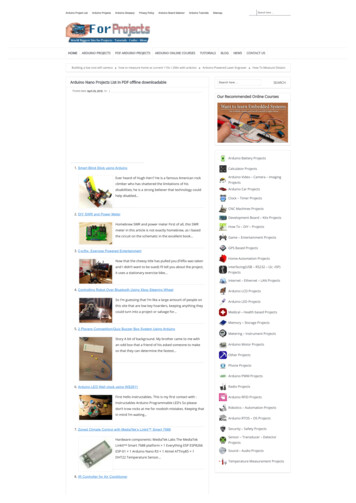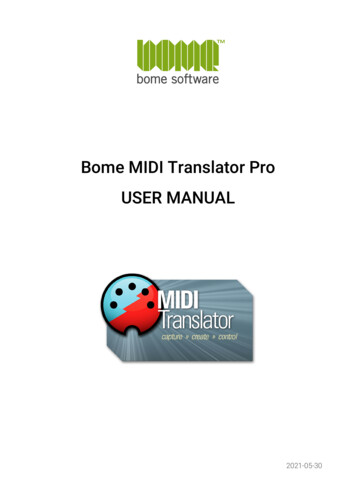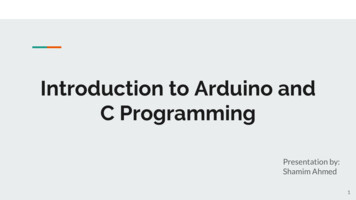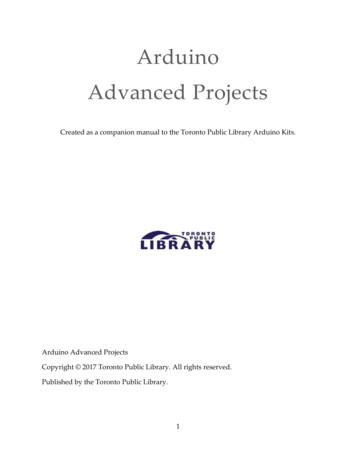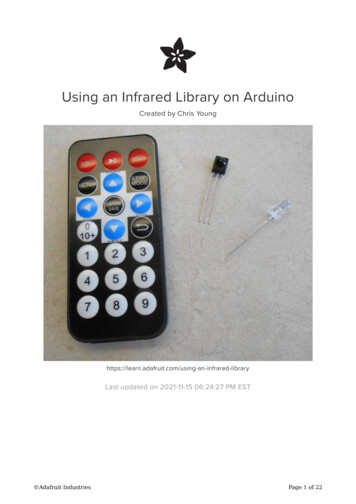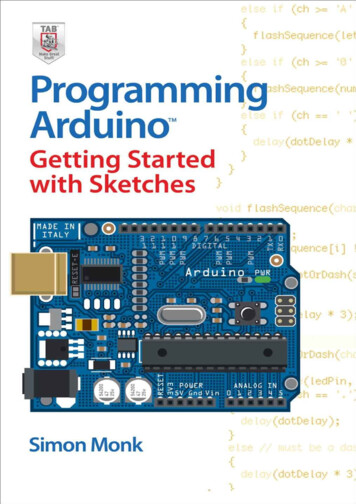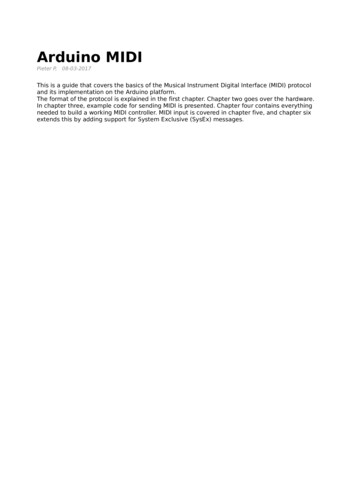
Transcription
Arduino MIDIPieter P,08-03-2017This is a guide that covers the basics of the Musical Instrument Digital Interface (MIDI) protocoland its implementation on the Arduino platform.The format of the protocol is explained in the first chapter. Chapter two goes over the hardware.In chapter three, example code for sending MIDI is presented. Chapter four contains everythingneeded to build a working MIDI controller. MIDI input is covered in chapter five, and chapter sixextends this by adding support for System Exclusive (SysEx) messages.
The MIDI protocolThe MIDI specification can be found here: 1-0-specificationThe MIDI protocol describes a set of MIDI events. For example, a note is played, or a note isturned off, a controller is moved and set to a new value, a new instrument is selected, etc. Theseevents correspond to MIDI messages that can be sent over the MIDI hardware connection.There are two main types of messages: channel messages and system messages. Mostperformance information will be sent as channel messages, while system messages are used forthings like proprietary handshakes, manufacturer-specific settings, sending long packets of data,real-time messages for synchronization and tuning, and other things that are not really ofinterest to someone who just wants to make an Arduino MIDI instrument or controller. That's whythis guide will mainly focus on channel messages.Channel messagesThere are 16 MIDI channels. Each MIDI instrument can play notes on one of these channels, andthey can apply different voices or patches to different channels, as well as setting somecontrollers like volume, pan, balance, sustain pedal, pitch bend, etc.MIDI messages that target a specific channel are called channel messages.A MIDI channel message consist of a header byte, referred to as the status byte, followed by oneor two data bytes:Status DataStatus Data 1 Data 2Each byte consists of 8 binary digits. To distinguish between status and data bytes, and toprevent framing errors, status bytes have the most significant bit (msb) set to one (1), and databytes have the msb set to zero (0).Status byteBitData byte 1Data byte 2 (optional)765432107654321076543210Value 1xxxxxxx0xxxxxxx0xxxxxxxStatus bytesThe status byte of channel messages is divided into two 4-bit nibbles. The high nibble (bits 4-7)specifies the message type, and the low nibble (bits 0-3) specifies the MIDI channel. Because themost significant bit has to be one, there are 8 different message types (0b1000 - 0b1111 or 0x8 0xF), and 16 different channels (0x0 - 0xF). Message type 0xF is used for system messages, so itwon't be covered in this section on channel messages.Status byteBit76543210Value m m m m nnnnWhere mmmm is the message type (0x8 - 0xE) and nnnn is the channel nibble.Note that the channels start from nnnn 0 for MIDI channel 1. (nnnn channel - 1)Data bytesEach data byte contains a 7-bit value, a number between 0 and 127 (0b01111111 or 0x7F). Themeaning of this value depends on the message type. For example, it can tell the receiver whatnote is played, how hard the key was struck, what instrument to select, what value a controller isset to, etc.Channel Messages: message typesThe following section will go over the different channel messages and their status and databytes.Keep in mind that nnnn channel - 1.
Note Off (0x8)A note off event is used to stop a playing note. For example, when a key is released.Data 1 (0b0kkkkkkk):Data 2 (0b0vvvvvvv):Note number (key). See MIDI note names.Velocity (how fast the key is released).A velocity of 0 is not defined, and some software or devices may not register the note offevent if the velocity is zero.Most software or devices will ignore the note off velocity.Instead of a note off event, a note on event with a velocity of zero may be used. This isespecially useful when using a running status.Status byteBitNote numberVelocity765432107654321076543210Value 1000nnnn0kkkkkkk0vvvvvvvNote On (0x9)A note on event is used to play a note. For example, when a key is pressed.Data 1 (0b0kkkkkkk):Data 2 (0b0vvvvvvv):Note number (key). See MIDI note names.Velocity (how fast/hard the key is pressed).If the velocity is zero, the note on event is interpreted as a note off event. This is especiallyuseful when using a running status.Status byteBitNote numberVelocity765432107654321076543210Value 1001nnnn0kkkkkkk0vvvvvvvPolyphonic key pressure (0xA)A polyphonic key pressure event is used when the pressure on a key or a pressure sensitive padchanges after the note on event.Data 1 (0b0kkkkkkk):Data 2 (0b0vvvvvvv):Note number (key). See MIDI note names.Pressure on the key.Most normal MIDI keyboards do not implement this event.Key pressure is sometimes referred to as after-touch or after-pressure.Status byteBitNote numberPressure765432107654321076543210Value 1010nnnn0kkkkkkk0vvvvvvvControl change (0xB)A control change event is used when the value of a controller changes.Data 1 (0b0ccccccc):Data 2 (0b0vvvvvvv):Controller number. See Controller numbers.The value of the controller.Controller numbers 120-127 are reserved as "Channel Mode Messages".Status byteBitController numberValue765432107654321076543210Value 1011nnnn0ccccccc0vvvvvvvProgram change (0xC)A program change event is used to change the program (i.e. sound, voice, tone, preset or patch)of a given channel is changed.Data 1 (0b0ppppppp):Program number. See Program numbers.
Controller numbers 120-127 are reserved as "Channel Mode Messages".Status byteBitProgram number7654321076543210Value 1100nnnn0cccccccChannel pressure (0xD)A channel pressure event is used when the pressure on a key or a pressure sensitive padchanges after the note on event. Unlike polyphonic key pressure, channel pressure affects allnotes playing on the channel.Data 1 (0b0vvvvvvv):Pressure value.Most normal MIDI keyboards do not implement this event.Channel pressure is sometimes referred to as after-touch or after-pressure.Status byteBitPressure7654321076543210Value 1101nnnn0vvvvvvvPitch bend change (0xE)A pitch bend change event is used to alter the pitch of the notes played on a given channel.Data 1 (0b0lllllll):Data 2 (0b0mmmmmmm):Least significant byte (bits 0-7) of the pitch bend value.Most significant byte (bits 8-13) of the pitch bend value.The center position (no pitch change) is represented by LSB 0x0, MSB 0x40Status byteBitLSBMSB765432107654321076543210Value 1110nnnn0lllllll0 m m m m m m mRunning statusThere are a lot of circumstances where you have to send many messages of the same type. Forexample, if you have a digital keyboard, pretty much all messages will be note on and note offevents, or when you turn a knob on a MIDI controller, a lot of control change messages will besent to update the controller value. To save bandwidth in these kinds of situations, you only haveto send the status byte once, followed by only data bytes. This technique is called "runningstatus".Because note on events are most likely to be followed by note off events (or more note onevents), the MIDI standard allows you to use a note on event with a velocity of zero instead of anote off event. This means that you only need one status byte for all note events, drasticallyreducing the data throughput, thus minimizing the delay between events.System MessagesSystem messages are MIDI messages that do not carry data for a specific MIDI channel. Thereare three types of system messages:System Common MessagesSystem Common messages are intended for all receivers in the system.These messages are beyond the scope of this guide. If you want more information, refer to page27 of the MIDI 1.0 Detailed Specification 4.2.MIDI Time Code Quarter Frame (0xF1)Song Position Pointer (0xF2)Song Select (0xF3)Tune Request (0xF6)EOX (End of Exclusive) (0xF7)
System Real Time MessagesSystem Real Time messages are used for synchronization between clock-based MIDIcomponents.These messages are beyond the scope of this guide. If you want more information, refer to page30 of the MIDI 1.0 Detailed Specification 4.2.Timing Clock (0xF8)Start (0xFA)Continue (0xFB)Stop (0xFC)Active Sensing (0xFE)System Reset (0xFF)System Exclusive MessagesSystem Exclusive (SysEx) messages are used for things like setting synthesizer or patch settings,sending sampler data, memory dumps, etc.Most SysEx messages are manufacturer-specific, so it is best to consult the MIDI implementationin the manual. If you want more information on the topic, you can find it on page 34 of the MIDI1.0 Detailed Specification 4.2.A system exclusive message starts with a status byte 0xF0, followed by an arbitrary number ofdata bytes, and ends with another status byte 0xF7.SysEx startBitData SysEx end7654321076543210 76543210Value 111100000ddddddd 11110111AppendicesAll numbers are in hexadecimal representation, unless otherwise specified.MIDI note namesMiddle C or C4 is defined as MIDI note 0x3C.The lowest note on a standard 88-key piano is A0 (0x15) and the highest note is C8 (0x6C).NoteOctave C C# D D#EFF# G G#A A# B-1 00 01 02 03 04 05 06 07 08 09 0A 0B0 0C 0D 0E 0F 10 11 12 13 14 15 16 171 18 19 1A 1B 1C 1D 1E 1F 20 21 22 232 24 25 26 27 28 29 2A 2B 2C 2D 2E 2F3 30 31 32 33 34 35 36 37 38 39 3A 3B4 3C 3D 3E 3F 40 41 42 43 44 45 46 475 48 49 4A 4B 4C 4D 4E 4F 50 51 52 536 54 55 56 57 58 59 5A 5B 5C 5D 5E 5F7 60 61 62 63 64 65 66 67 68 69 6A 6B8 6C 6D 6E 6F 70 71 72 73 74 75 76 779 78 79 7A 7B 7C 7D 7E 7FController numbersThis is an overview of the MIDI controller numbers that can be used as the first data byte of acontrol change event.The second data byte is the value for the controller. This value is 7 bits wide, so has a range of[0, 127]. Controller numbers 0x00-0x1F can be combined with numbers 0x20-0x3F for 14-bitresolution. In this case, numbers 0x00-0x1F set the MSB, and numbers 0x20-0x3F the LSB.Controller numbers 120-127 are reserved for Channel Mode Messages, which rather thancontrolling sound parameters, affect the channel's operating mode.ControllerFunctionValueUsed
asDec Hex000Bank Select00-7FMSB101Modulation Wheel or Lever00-7FMSB202Breath Controller00-7FMSB303Undefined00-7FMSB404Foot Controller00-7FMSB505Portamento Time00-7FMSB606Data Entry MSB00-7FMSB707Channel Volume (formerly Main MSB100APan00-7FMSB110BExpression Controller00-7FMSB120CEffect Control 100-7FMSB130DEffect Control B1610General Purpose Controller 100-7FMSB1711General Purpose Controller 200-7FMSB1812General Purpose Controller 300-7FMSB1913General Purpose Controller ned00-7FMSB3220LSB for Control 0 (Bank Select)00-7FLSB3321LSB for Control 1 (Modulation Wheel or Lever)00-7FLSB3422LSB for Control 2 (Breath Controller)00-7FLSB3523LSB for Control 3 (Undefined)00-7FLSB3624LSB for Control 4 (Foot Controller)00-7FLSB3725LSB for Control 5 (Portamento Time)00-7FLSB3826LSB for Control 6 (Data Entry)00-7FLSB3927LSB for Control 7 (Channel Volume, formerly Main Volume)00-7FLSB4028LSB for Control 8 (Balance)00-7FLSB4129LSB for Control 9 (Undefined)00-7FLSB422ALSB for Control 10 (Pan)00-7FLSB432BLSB for Control 11 (Expression Controller)00-7FLSB442CLSB for Control 12 (Effect control 1)00-7FLSB452DLSB for Control 13 (Effect control 2)00-7FLSB462ELSB for Control 14 (Undefined)00-7FLSB472FLSB for Control 15 (Undefined)00-7FLSB4830LSB for Control 16 (General Purpose Controller 1)00-7FLSB4931LSB for Control 17 (General Purpose Controller 2)00-7FLSB5032LSB for Control 18 (General Purpose Controller 3)00-7FLSB
5133LSB for Control 19 (General Purpose Controller 4)00-7FLSB5234LSB for Control 20 (Undefined)00-7FLSB5335LSB for Control 21 (Undefined)00-7FLSB5436LSB for Control 22 (Undefined)00-7FLSB5537LSB for Control 23 (Undefined)00-7FLSB5638LSB for Control 24 (Undefined)00-7FLSB5739LSB for Control 25 (Undefined)00-7FLSB583ALSB for Control 26 (Undefined)00-7FLSB593BLSB for Control 27 (Undefined)00-7FLSB603CLSB for Control 28 (Undefined)00-7FLSB613DLSB for Control 29 (Undefined)00-7FLSB623ELSB for Control 30 (Undefined)00-7FLSB633FLSB for Control 31 (Undefined)00-7FLSB6440Damper Pedal on/off (Sustain) 3F off, 40 on---6541Portamento On/Off 3F off, 40 on---6642Sostenuto On/Off 3F off, 40 on---6743Soft Pedal On/Off 3F off, 40 on---6844Legato Footswitch 3F Normal, 40Legato---6945Hold 2 3F off, 40 on---7046Sound Controller 1 (default: Sound Variation)00-7FLSB7147Sound Controller 2 (default: Timbre/Harmonic Intens.)00-7FLSB7248Sound Controller 3 (default: Release Time)00-7FLSB7349Sound Controller 4 (default: Attack Time)00-7FLSB744ASound Controller 5 (default: Brightness)00-7FLSB754BSound Controller 6 (default: Decay Time - see MMA RP-021)00-7FLSB764CSound Controller 7 (default: Vibrato Rate - see MMA RP-021)00-7FLSB774DSound Controller 8 (default: Vibrato Depth - see MMA RP-021)00-7FLSB784ESound Controller 9 (default: Vibrato Delay - see MMA RP-021)00-7FLSB794FSound Controller 10 (default undefined - see MMA RP-021)00-7FLSB8050General Purpose Controller 500-7FLSB8151General Purpose Controller 600-7FLSB8252General Purpose Controller 700-7FLSB8353General Purpose Controller 800-7FLSB8454Portamento ---8757Undefined8858High Resolution Velocity ed------915BEffects 1 Depth (default: Reverb Send Level - see MMA RP-023)(formerly ExternalEffects Depth)00-7F---925CEffects 2 Depth (formerly Tremolo Depth)00-7F---935DEffects 3 Depth (default: Chorus Send Level - see MMA RP-023)(formerly Chorus Depth)00-7F---945EEffects 4 Depth (formerly Celeste [Detune] Depth)00-7F---955FEffects 5 Depth (formerly Phaser Depth)00-7F---9660Data Increment (Data Entry 1) (see MMA RP-018)N/A---9761Data Decrement (Data Entry -1) (see MMA RP-018)N/A---9862Non-Registered Parameter Number (NRPN) - LSB00-7FLSB9963Non-Registered Parameter Number (NRPN) - MSB00-7FMSB10064Registered Parameter Number (RPN) - LSB*00-7FLSB
10165Registered Parameter Number (RPN) - --11977Undefined------ChannelmodeFunctionValueDec Hex12078All Sound Off0012179Reset All Controllers001227A Local Control On/Off1237B All Notes Off1247COmni Mode Off ( allnotes off)001257DOmni Mode On ( allnotes off)001267EMono Mode On ( polyoff, all notes off)Note: This equals the number of channels, or zero if the number ofchannels equals the number of voices in the receiver.1277FPoly Mode On ( monooff, all notes off)000 off, 7F on00SourceProgram numbersThe MIDI specification doesn't specify instruments or voices for program numbers. The GeneralMIDI 1 sound set does define a list of sounds and families of sounds.Program Family Name1-8Piano9-16Chromatic nth Lead89-96Synth Pad97-104Synth Effects
105-112Ethnic113-120Percussive121-128Sound EffectsProgram Instrument Name1Acoustic Grand Piano2Bright Acoustic Piano3Electric Grand Piano4Honky-tonk Piano5Electric Piano 16Electric Piano 27Harpsichord8Clavi9Celesta10Glockenspiel11Music Box12Vibraphone13Marimba14Xylophone15Tubular Bells16Dulcimer17Drawbar Organ18Percussive Organ19Rock Organ20Church Organ21Reed Organ22Accordion23Harmonica24Tango Accordion25Acoustic Guitar (nylon)26Acoustic Guitar (steel)27Electric Guitar (jazz)28Electric Guitar (clean)29Electric Guitar (muted)30Overdriven Guitar31Distortion Guitar32Guitar harmonics33Acoustic Bass34Electric Bass (finger)35Electric Bass (pick)36Fretless Bass37Slap Bass 138Slap Bass 239Synth Bass 140Synth Bass 241Violin42Viola43Cello44Contrabass45Tremolo Strings46Pizzicato Strings47Orchestral Harp48Timpani
49String Ensemble 150String Ensemble 251SynthStrings 152SynthStrings 253Choir Aahs54Voice Oohs55Synth Voice56Orchestra Hit57Trumpet58Trombone59Tuba60Muted Trumpet61French Horn62Brass Section63SynthBrass 164SynthBrass 265Soprano Sax66Alto Sax67Tenor Sax68Baritone Sax69Oboe70English 6Pan Flute77Blown Bottle78Shakuhachi79Whistle80Ocarina81Lead 1 (square)82Lead 2 (sawtooth)83Lead 3 (calliope)84Lead 4 (chiff)85Lead 5 (charang)86Lead 6 (voice)87Lead 7 (fifths)88Lead 8 (bass lead)89Pad 1 (new age)90Pad 2 (warm)91Pad 3 (polysynth)92Pad 4 (choir)93Pad 5 (bowed)94Pad 6 (metallic)95Pad 7 (halo)96Pad 8 (sweep)97FX 1 (rain)98FX 2 (soundtrack)99FX 3 (crystal)100FX 4 (atmosphere)
101FX 5 (brightness)102FX 6 (goblins)103FX 7 (echoes)104FX 8 ba110Bag pipe111Fiddle112Shanai113Tinkle Bell114Agogo115Steel Drums116Woodblock117Taiko Drum118Melodic Tom119Synth Drum120Reverse Cymbal121Guitar Fret Noise122Breath Noise123Seashore124Bird Tweet125Telephone Ring126Helicopter127Applause128GunshotSource
MIDI hardwareThe MIDI hardware link is just a 5mA current loop that asynchronously sends and receives 8-bitbytes at a baud rate of 31250 symbols per second. This means that the Arduino's hardware UARTcan be used for transmitting and receiving MIDI. DIN 5 pin (180 degree) female receptacles areused for MIDI in, out and through connectors.This is the original schematic that can be found in the 1996 MIDI 1.0 Detailed Specification 4.2:The current loop consists of a an open collector output on the transmitting end (MIDI out andMIDI through), and an opto-isolator at the receiving end (MIDI in). When a 'zero' is sent, the opencollector output sinks current, turning on the LED of the opto-isolator. This will in turn bring lowthe open collector output of the opto-isolator, resulting in a low signal.The reason for using a current loop instead of a voltage, is that the sender and the receiver can
be at different potentials, because everything is galvanically isolated. This also prevents groundloops, which can result in noise.Note that the ground and shielding (pin 2 on the 5-pin DIN connector) is connected to the groundof the MIDI out and through circuits, but not to the ground of the receiver in the MIDI in circuit.The standard was updated in 2014 to include specifications for 3.3V MIDI devices.( MIDI 1.0 Electrical Specification Update (CA-033) (2014). MMA Technical Standards Board / AMEIMIDI Committee.)Pin 2 must be tied to ground on the MIDI transmitteronly.The buffer between the UART transmitter and R C isoptional and system-dependent.The UART is configured with 8 data bits, no parity, and 1stop bit, or 8-N-1.The resistor values depend on the transmission signalingvoltage, V TX, as detailed below.The optional ferrite beads are 1k-ohm at 100MHz such asMMZ1608Y102BT or similar.Do not connect any pins of the MIDI IN jackdirectly to groundVRXJack shield – N/C or optional smallcapacitor (0.1 µF typical) to improveEMI/EMC performanceINN/C13N/C425Optional ferrite beads toimprove EMI/EMCperformance 5V 10% 3.3V 5%RA220Ω 5% 0.25W33Ω 5% 0.5WRC220Ω 5% 0.25W10Ω 5% 0.25WValue of RDdepends on optoisolator and VRX.Recommended valueis 280Ω for PC900Vwith VRX 5V.Optional MIDI Thru CircuitVTXJack shield – N/C oroptional ground to improveEMI/EMC performanceRDFB31K @100MHzFB41K @100MHzVTXD11N914RB220Opto-Isolatorsuch asPC900V or 6N138Reverse voltageprotection foropto-isolatorPin 2 – N/C or optional smallcapacitor (0.1 µF typical) toimprove RF grounding31,250 bits/secUART ReceiverTHRUREFB51K @100MHzN/C1342N/C5FB61K @100MHzRFOptional ferrite beads toimprove EMI/EMCperformanceChoose RE and RF based on VTX in thesame way as described for MIDI Out RAand RC
Sending MIDI over SerialThe easiest way to send out MIDI packets is to use the Serial.write(uint8 t data); function. Thisfunction writes out one 8-bit byte over the Serial connection (either hardware UART0 or thevirtual COM port over USB).To send out a MIDI packet, we just have to write out the three bytes that make up the packet:first the status byte, then the two data bytes.void sendMIDI(uint8 t statusByte, uint8 t dataByte1, uint8 t dataByte2) Serial.write(dataByte2);}In order to support MIDI packets with only one data byte as well, we can just overload thesendMIDI function. This means that we create two functions with the same name, but withdifferent parameters.void sendMIDI(uint8 t statusByte, uint8 t dataByte) In its current form, the sendMIDI function is quite silly. Although it sends out MIDI packets, itdoesn't automatically create these packets for us, we still have to put together the status anddata bytes ourselves, and we have to make sure that it is a valid MIDI packet before callingsendMIDI. Let's create a more useful function that takes a message type, channel number anddata as inputs, creates a MIDI packet, and sends it over the Serial port.void sendMIDI(uint8 t messageType, uint8 t channel, uint8 t data1, uint8 t data2) {channel--; // Decrement the channel, because MIDI channel 1 corresponds to binary channel 0uint8 t statusByte messageType channel; // Combine the messageType (high nibble)// with the channel (low nibble)// Both the message type and the channel should be4 bits erial.write(data2);}We now have a working function that sends MIDI packets, and takes a somewhat sensible input,not just the bytes of the packet. But there's still no guarantee that it is a valid MIDI message.Remember that the status byte should have a most significant bit equal to 1, and the data bytesa most significant bit equal to 0. We'll use some bitwise math to make sure that this is always thecase, no matter what data the user enters.void sendMIDI(uint8 t messageType, uint8 t channel, uint8 t data1, uint8 t data2) {channel--;// Decrement the channel, because MIDI channel 1// corresponds to binary channel 0uint8 t statusByte messageType channel; // Combine the messageType (high nibble)// with the channel (low nibble)// Both the message type and the channel// should be 4 bits widestatusByte 0b10000000;// Set the most significant bit of the status bytedata1& 0b01111111;// Clear the most significant bit of the databytesdata2& 0b01111111;Serial.write(statusByte);// Send over d sendMIDI(uint8 t messageType, uint8 t channel, uint8 t data) {channel--;// Decrement the channel, because MIDI channel 1// corresponds to binary channel 0uint8 t statusByte messageType channel; // Combine the messageType (high nibble)// with the channel (low nibble)// Both the message type and the channel// should be 4 bits wide
}statusByte 0b10000000;data& ata);// Set the most significant bit of the status byte// Clear the most significant bit of the data byte// Send over SerialBefore sending the packet, we set the most significant bit of the status byte by performing abitwise OR operation:0bxsss ssss0b1000 0000----------- 0b1sss ssssWhere 0bsss ssss is the status, and x is either 1 or 0. As you can see, no matter the value of x, theresult will always be 0b1sss ssss.We also clear the most significant bits of the data bytes by performing a bitwise AND operation:0bxddd dddd0b0111 1111----------- &0b0ddd ddddWhere 0bddd dddd is the data, and x is either 1 or 0. No matter what the value of x is, the resultwill always be 0b0ddd ddddYou could go even further by making sure that the message type and the channel don't interferewith each other. However, that might be overly defensive.void sendMIDI(uint8 t messageType, uint8 t channel, uint8 t data1, uint8 t data2) {channel--;// Decrement the channel, because MIDI channel 1// corresponds to binary channel 0messageType & 0b11110000;// Make sure that only the high nibble// of the message type is setchannel& 0b00001111;// Make sure that only the low nibble// of the channel is setuint8 t statusByte messageType channel; // Combine the messageType (high nibble)// with the channel (low nibble)// Both the message type and the channel// should be 4 bits widestatusByte 0b10000000;// Set the most significant bit of the status bytedata1& 0b01111111;// Clear the most significant bit of the databytesdata2& 0b01111111;Serial.write(statusByte);// Send over roving readabilityTo send a Control Change (0xB0) message on channel 3 for controller 80 with a value of 64, youwould call sendMIDI(0xB0, 3, 80, 64);To make it a little more obvious what's going on, we could declare some constants for thedifferent message types:constconstconstconstconstconstconstuint8 tuint8 tuint8 tuint8 tuint8 tuint8 tuint8 tNOTE OFF 0x80;NOTE ON 0x90;KEY PRESSURE 0xA0;CC 0xB0;PROGRAM CHANGE 0xC0;CHANNEL PRESSURE 0xD0;PITCH BEND 0xE0;You can now use sendMIDI(CC, 3, 80, 64); which will make the code much easier to read.When writing code, it's always a good idea to keep so-called magic numbers to a minimum.These are seemingly arbitrary numeric literals in your code that don't have a clear meaning.For example, this code snippet plays a chromatic glissando (all keys, one after the other) on anhonky-tonk piano:sendMIDI(0xC0, 1, 4);for (uint8 t i 21; i 108; i ) {sendMIDI(0x90, 1, i, 64);delay(100);
sendMIDI(0x80, 1, i, 64);}To someone who has never seen the code, or someone who doesn't know all MIDI message typecodes by heart, it's not clear what all these numbers mean. A much better sketch would be:const uint8 t honkyTonkPiano 4;// GM defines the Honky-tonk Piano as instrument #4const uint8 t note A1 21; // lowest note on an 88-key pianoconst uint8 t note C9 108; // highest note on an 88-key pianouint8 t channel 1;uint8 t velocity 64;// MIDI channel 1// 64 mezzo fortesendMIDI(PROGRAM CHANGE, channel, honkyTonkPiano);for (uint8 t note note A1; note note C9; note ) {keyssendMIDI(NOTE ON, channel, note, velocity);delay(100);sendMIDI(NOTE OFF, channel, note, velocity);}// chromatic glissando over all 88 pianoThis snippet does exactly the same thing as the previous example, but it's much easier to readand understand.Using structsAnother approach would be to compose the MIDI message in a buffer, and then just write outthat buffer. We can define a struct with the different fields of a MIDI event. Take a look at thisstruct:typedef struct MIDI message 3B {unsigned int channel : 4;// second nibble : MIDI channel (0-15)unsigned int status : 3;// first nibble : status messageunsigned int msb0 : 1;// most significant bit of status byte : should be 1 according toMIDI specificationunsigned int data1 : 7;// second byte: first valueunsigned int msb1 : 1;// most significant bit of first data byte : should be 0 accordingto MIDI specificationunsigned int data2 : 7;// third byte: second valueunsigned int msb2 : 1;// most significant bit of second data byte : should be 0 accordingto MIDI specificationMIDI message 3B() : msb0(1), msb1(0), msb2(0) {} // set the correct msb's for MIDI};You might have noticed that the bit fields are in the wrong order: for example, the normal orderof the status byte would be 1.mmm.cccc with mmm the message type and cccc the channel.However, the order in our struct is cccc.mmm.1. To understand what's going on, you have to knowthat Arduinos are Little Endian. This means that the first bit field takes up the least significantbits in each byte. In other words, the bit fields within each byte are in reversed order, comparedto the conventional Big Endian notation (that is used in the MIDI specification).You can now fill up all fields of the struct, to create a valid MIDI packet. You don't have to worryabout the most significant bits of each byte, bitmasking is done automatically, because of the bitfields. These bits are set to the correct value when a message is created, in the initializer list ofthe constructor. The only thing you need to keep in mind is that the channels are zero-based.Also note that the message types are no longer 0x80, 0x90 etc., but 0x8, 0x9 .const uint8 t NOTE ON 0x9;MIDI message 3B msg; // Create a variable called 'msg' of the 'MIDI message 3B' type we justdefinedmsg.status NOTE ON;msg.channel channel - 1; // MIDI channels start from 0, so subtract 1msg.data1 note A1;msg.data2 velocity;Finally, you can just write out the message over the Serial port. We'll create another overload ofthe sendMIDI function:
void sendMIDI(MIDI message 3B msg) {Serial.write((uint8 t *)&msg, 3);}We're using the write(uint8 t* buffer, size t numberOfBytes) function. The first argument is apointer to a buffer (or array) of data bytes to write out. The pointer points to the first element ofthis array. The second argument is the number of bytes to send, starting from that first element.There's one minor problem: msg is not an array, it's an object of type MIDI message 3B. The writefunction expects a pointer to an array of bytes (uint8 t). To get around this, we can just take theaddress of msg, using the address-of operator (&) and cast it to a pointer to an array of uint8 t'susing (uint8 t*). We need to write out the entire MIDI packet, which is 3 bytes long, so thesecond argument is just 3.To use the function, just use:sendMIDI(msg);In fact, we could do even better. Now every time the sendMIDI function is called, the msg object iscopied. This takes time and memory. To prevent it from being copied, we can pass only areference to msg to the function. Here's what that looks like:void sendMIDI(MIDI message 3B &msg
Arduino MIDI Pieter P, 08-03-2017 This is a guide that covers the basics of the Musical Instrument Digital Interface (MIDI) protocol and its implementation on the Arduino platform. The format of the protocol is explained in the first chapter. Chapter two goes over the hardware. In c

